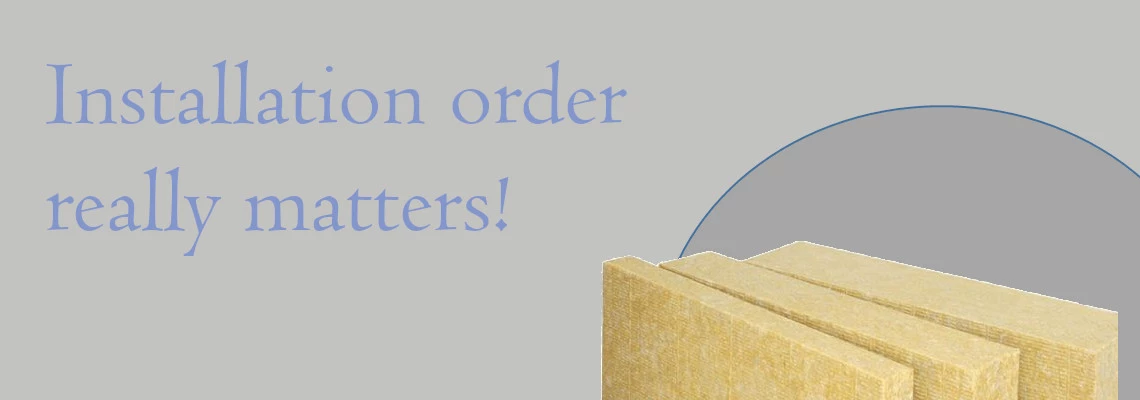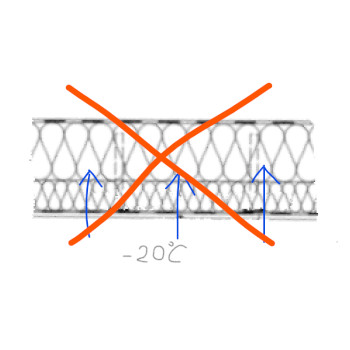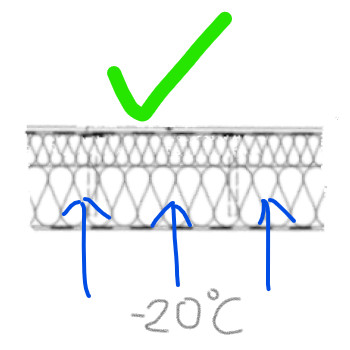
WHAT'S THE BEST WAY TO MAKE THE MOST OF THERMAL INSULATION?*
Thermal insulation - like slabs, rolls, or rigid boards - has a job: it keeps our homes cosy by blocking out the cold and keeping the right temperature inside. If you are about to fit insulation wrong way, it can cause big problems like thermal bridges that can't be fixed. Even if you have the top-notch insulation with the highest R-value, it can end up useless if it's put in the wrong order.
In this brief article, we'll closely examine this problem. We'll explain why it's crucial to fit thick insulation first and highlight key factors to consider when selecting thermal insulation for your project.
INSULATION THICKNESS VERSUS INSTALLATION ORDER
The thickness of thermal insulation is often defined by its high R-value. Generally speaking, the higher the R-value, the better for you. To achieve a decent R-value above 4.5m²K/W, it's necessary to use a thicker layer of insulation often above 150mm.
 The issue arises at this particular point. For instance, floor joists might have specific heights, forcing us to divide the insulation thickness differently, say into thirds.
The issue arises at this particular point. For instance, floor joists might have specific heights, forcing us to divide the insulation thickness differently, say into thirds.
What impact does this have on us? It means that when we're installing insulation, like in a loft where we need 300mm thickness, we should buy varying thicknesses like 200mm and 100mm to reach the total 300mm required for the desired R-value.
One layer of insulation is fitted between the roof rafters or floor joists to match their height, while the second layer typically spans across them. This brings up the question: should the thicker insulation layer or the thinner one be installed first?
Understanding the right way to install insulation is super important. If it's done the wrong way, it can cost a lot of money and make the attic smaller or raise the floor higher than needed.
 Imagine a really cold day in the UK, like -20°C. Let's say we're putting in 300mm of horizontal floor insulation without considering the order. If we start with the thin layer and then add the thick one, trouble happens. At -20°C, the thin layer freezes fast, and within a day, that cold hits the thicker layer. Since it's much thicker, it holds onto the cold, keeping it from the floor. It's like spending money on the first layer that doesn't really stop the cold. But if we flipped it, putting the thickest layer against the cold and the thinner layer against the warmer side, we'd avoid this issue.
Imagine a really cold day in the UK, like -20°C. Let's say we're putting in 300mm of horizontal floor insulation without considering the order. If we start with the thin layer and then add the thick one, trouble happens. At -20°C, the thin layer freezes fast, and within a day, that cold hits the thicker layer. Since it's much thicker, it holds onto the cold, keeping it from the floor. It's like spending money on the first layer that doesn't really stop the cold. But if we flipped it, putting the thickest layer against the cold and the thinner layer against the warmer side, we'd avoid this issue.
Also, using two layers of 100/200mm insulation means losing 100mm of space unnecessarily, which costs more.
 Doing it the right way – thicker insulation facing the cold side and thinner towards the warmer side – makes sure it works well and gives you the best insulation value.
Doing it the right way – thicker insulation facing the cold side and thinner towards the warmer side – makes sure it works well and gives you the best insulation value.
For instance, if we set it up correctly with a 200mm thick layer followed by a 100mm layer, at -20°C, the first thicker layer stops the cold. Then, adding the 100mm layer not only stops cold spots but also makes the insulation thicker overall, hitting the targeted insulation value.
When installing thermal insulation in two layers, always position the thicker insulation layer on the colder side and the thinner layer on the warmer side! This principle is crucial to ensure the insulation functions effectively and maintains the desired indoor temperature.
MIXED INSULATION. HOW DO I GO ABOUT IT?
Sometimes, you'll need to use two types of insulation to reach a certain U-value. But how you put them together really matters. If you mix them up, the overall insulation effectiveness might suffer.
The trick is to layer different types of insulation so that each one does its job properly. For instance, let's say we're dealing with phenolic boards and PIR boards. We want to put them close to each other, but we're not sure which one should go first.
Here's the tip: check their labels for the highest R-value. The one with the highest R-value, like phenolic boards with the lowest thermal conductivity (0.018W/mK), goes on the colder side as it provides the best insulation. Then, the one with slightly higher thermal conductivity, such as PIR boards (around 0.022W/mK), goes on the warmer side of the room. This way, they work together to keep things cosy inside.
If you place these two insulation types in the wrong order, the one with a lower R-value might not do enough to keep the cold out. This means you're not just wasting money on that particular insulation thickness but, more significantly, losing space unnecessarily because of using that specific insulation thickness.
Here's another helpful tip: when combining two types of insulation, begin from the cold side with the material having lower thermal conductivity (higher R-value). For the second layer, opt for insulation with a lower R-value (higher thermal conductivity).
This approach guarantees the most efficient performance of the combined thermal insulation layers.
COMBINING THERMAL INSULATION WITH DIFFERENT DENSITY
XPS + PIR
Generally speaking, there are 5 main types of insulation to choose from: extruded polystyrene (XPS), expanded polystyrene (EPS), PIR foam, phenolic foam, and mineral wool. Each of these insulation types has a different density which simply means that each of them is used for different purposes. For example, rigid products such extruded polystyrene with a compressive strength above 300 kPa are characterised by high comressive strength , making them suitable for floor insulation.
PIR boards with a compressive strength of 120 kPa are also commonly used for floor insulation. Can these two types of insulation be used together, especially considering that PIR boards typically have an aluminium foil layer? Yes, this foil serves excellently to reflect heat, especially in the case of underfloor heating applications.
PIR + MINERAL STONE WOOL
When combining two types of thermal insulation, it is important to select and install them in such a way that the sturdier type of insulation always lies on the side facing the heaviest loads, while the layer with lower compressive strength faces the lighter loads. Installing them in the opposite way exposes the weaker insulation layer to deformation and may cause the floor screed to lower and crack.
Similarly, let's consider combining PIR boards with rock wool, known for its acoustic insulation properties. Rock wool slabs with a density of 100kg/m³ provide better soundproofing, superior to PIR boards which, in foam form, do not contain air-filled spaces and hence do not block noise.
When combining these two types of insulation, it's advisable to use rock wool on the side with the highest noise level, expressed in dB, and the PIR board on the quieter side. This ensures the optimal utilisation of the acoustic properties of one of the insulation layers, in this case, the rock wool.
WHAT IS THE RATIONALE BEHIND MIXING DIFFERENT TYPES OF INSULATION?
Mixing different types of insulation is becoming more common and makes sense in several specific cases below:
Specific Properties:
Combining various insulation materials can lead to improved insulation properties, such as better energy efficiency or enhanced acoustic properties.
Drawbacks:
Some insulations may have specific drawbacks that other types can compensate for. Mixing them can help mitigate these weaknesses, providing better thermal or acoustic protection.
For instance, one material might excel in sound blocking, while another has superior thermal properties.
Specific Needs:
Each project might require specific insulation properties. Mixing insulations allows for adaptation to these needs, ensuring optimal results.
Mixing different types of insulation makes sense to enhance their effectiveness. Interestingly, some insulation manufacturers have started producing insulation products with two layers. These products contain the original core materials from the manufacturer along with an additional layer borrowed from other manufacturers' different types of insulation.
Depending on the thickness of the insulation core, this can be an interesting alternative to expensive products with high R-values such as phenolic foam.
CONCLUSION
To sum it up, using two layers of insulation is effective in eliminating thermal bridges and boosting their overall efficiency, but it's crucial to install them in the right order. Placing the thicker insulation on the colder side and the thinner one on the warmer side ensures optimal comfort and temperature regulation within your home. Installing them differently might lead to wasted expenses if the initial layer fails to perform as expected.
Using two different types of insulation to insulate a specific part of building is a smart move. It can significantly boost its insulation effectiveness, add extra functionalities, and potentially solve multiple issues simultaneously.
Mixing various insulation materials can bring numerous benefits. For instance, combining foam insulation with mineral wool may enhance both thermal and acoustic insulation while providing additional moisture protection. Employing such a combination can be a smart way to improve a room's energy efficiency and enhance user comfort. Additionally, different types of insulation can address diverse needs in various areas of a building's construction, offering comprehensive solutions for improved efficiency and energy performance.
Related articles:
THE BIGGER THE R, THE SMOOTHER THE RIDE!
DOUBLE INSULATION LAYERS: INSTALLATION TIPS
INSULATION THICKNESS ESSENTIALS
WHAT IS THE NEWEST FUTURE INSULATION?
*
Insulationgo LTD strives to keep the content accurate and up-to-date, but we cannot be held responsible for any mistakes or exclusions.
The information in this blog isn't expert advice and shouldn't replace talking to the right specialists. Before buying or deciding anything based on this info, it's best to contact the product manufacturer directly to double-check if it's right for what you need.
Descriptions, drawings, photographs, data, proportions, weights, and measured values provided here may change without prior notice and do not establish the guaranteed contractual quality of the products. The recipient of these products holds the responsibility to comply with proprietary rights, existing laws, and legislation.
Using this blog implies acknowledgment and agreement that Insulationgo LTD cannot be held accountable for any damages, losses, or inconveniences resulting from the use or reliance upon the information provided. This limitation of liability extends to all users of the blog, including visitors, readers, and subscribers.










































































































